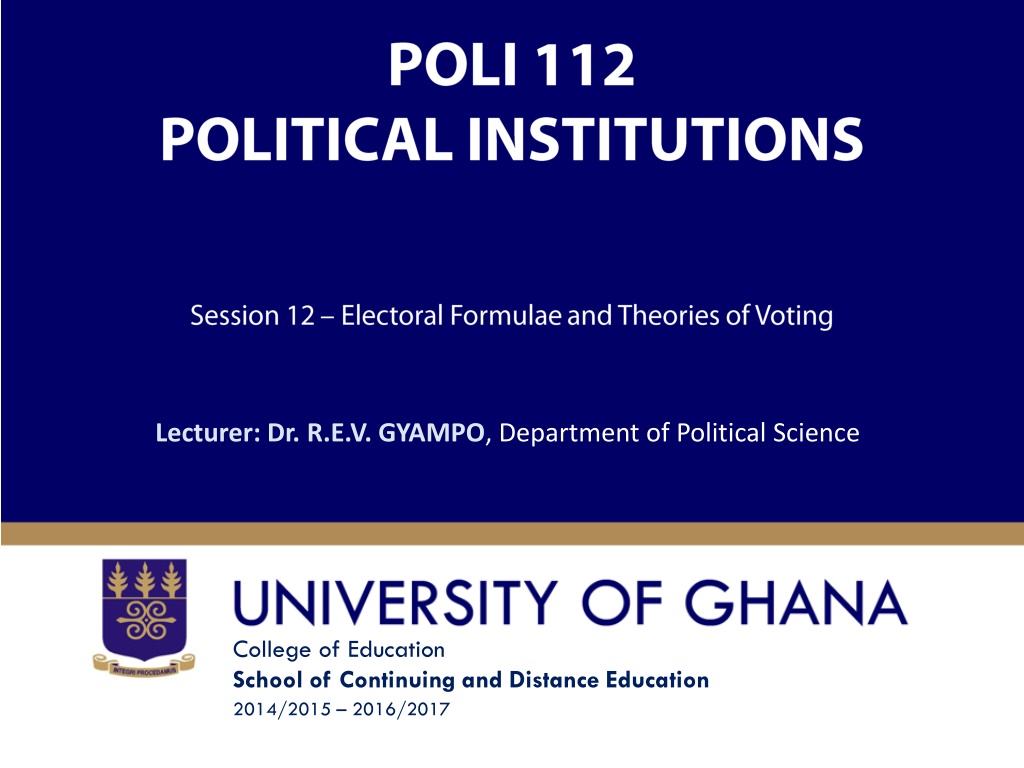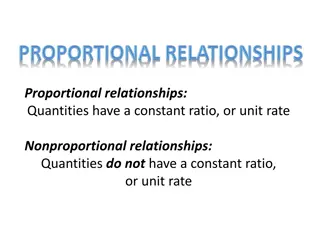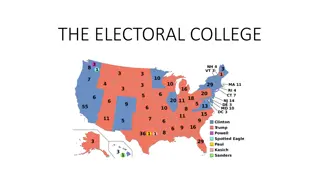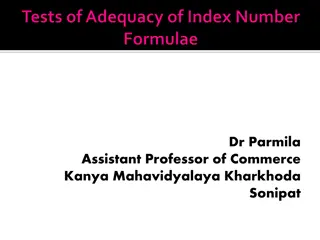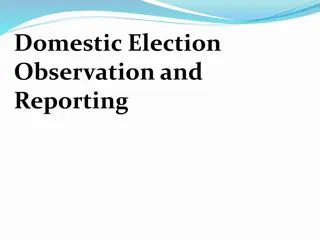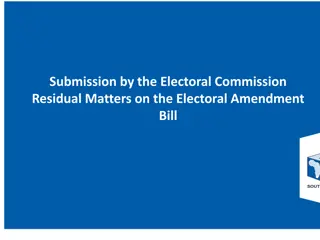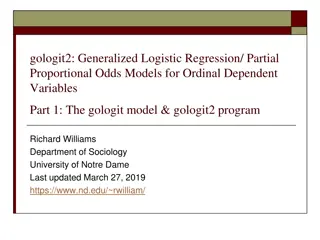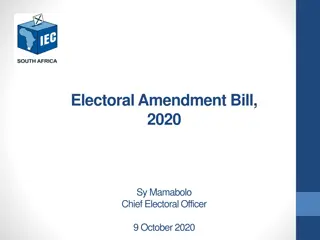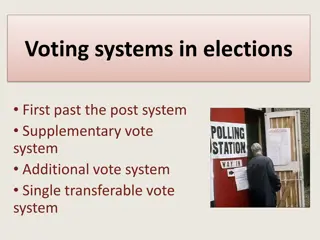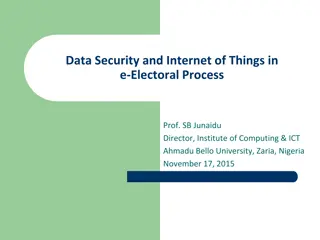Understanding Electoral Formulas and Proportional Representation
Electoral formulas play a crucial role in translating individual votes into legislative seats, with systems like Proportional Representation and Winner-Takes-All affecting government structure and representation. Proportional systems aim for fair seat allocation based on vote share, while non-proportional systems prioritize majority governments and simple representation. Dr. R.E.V. Gyampo discusses these systems and their impact in political science.
Download Presentation

Please find below an Image/Link to download the presentation.
The content on the website is provided AS IS for your information and personal use only. It may not be sold, licensed, or shared on other websites without obtaining consent from the author. Download presentation by click this link. If you encounter any issues during the download, it is possible that the publisher has removed the file from their server.
E N D
Presentation Transcript
Lecturer: Dr. R.E.V. GYAMPO, Department of Political Science College of Education School of Continuing and Distance Education 2014/2015 2016/2017
Defining Electoral Formula These are systems that sets the rules for determining how individual votes are translated into legislative seats. There are the Proportional Representation system and the Winner-Takes-All, First-Past the-Post system or the Non- Proportional systems Non-Proportional systems are generally defended for their tendency to produce majority governments; simplicity; and encouraging strong territorially defined links between representatives and their constituents who voted for them Proportional systems on the other hand are defended for the greater fairness in awarding seats that are roughly proportional to the share of votes obtained by each party Slide 2 Dr. R.E.V. GYAMPO Dept of Political Science, UG
It is for example practiced in Britain while the Non-Proportional System Elections to Parliament in Ghana is based on a simple majority or first-past the post where the country is divided into a single-member constituency with one representative selected from each constituency There is also an additional but less common non-proportional system called the Majoritarian System. In this system the wining candidate is required to earn a majority of votes (fifty percent plus one) in order to be declared a winner. Slide 3 Dr. R.E.V. GYAMPO Dept of Political Science, UG
Proportional System Proportional Representation as an electoral formula uses a different measure for determining seat allocation. The priority lies in awarding seats to parties in proportion to the share of votes earned rather than awarding seats to single candidates from each constituency All proportional representation multimember constituencies or districts because it is impossible to divide a single seat among several candidates. The higher the number of members to be elected, the more proportional the system is likely to be systems use Slide 4 Dr. R.E.V. GYAMPO Dept of Political Science, UG
The List and Single Transferable Systems of Prop. Representation There are two specific proportional representation systems. These are the list system and the single transferable vote. Most proportional representation systems use the list system, which requires voters to choose from among the lists of candidates prepared by the parties. In a closed-list system, voters cannot indicate preferences for candidates on a party s list but must vote for the list as determined by the party. Candidates, then, are elected according to their order on that list. Slide 5 Dr. R.E.V. GYAMPO Dept of Political Science, UG
The List and Single Transferable Systems of Prop. Representation (Cont An open list system on the other hand, allows voters to choose and rank specific candidates from among the party list, thereby weakening the power of party officials to determine who gets elected into the legislature. On the other hand, the single transferable votes, which requires voters to rank their candidate preferences on the ballot, in a manner similar to the method employed in the alternative vote system Slide 6 Dr. R.E.V. GYAMPO Dept of Political Science, UG
Theories of Voting Andrew Heywood has identified four main theories of voting. These are The Party Identification Model Sociological Model Rational Choice Model Dominant Ideology Model Slide 7 Dr. R.E.V. GYAMPO Dept of Political Science, UG
Party Identification Model Under Party Identification, people vote for political parties and not the candidates that contests elections. In this regard, emphasis is placed on the party and not the quality of the human being contesting on the party s ticket It sometimes promotes the election of incompetent people as respresentatives Slide 8 Dr. R.E.V. GYAMPO Dept of Political Science, UG
Sociological Model Voting under this model is influenced by sociological considerations such as where one hails from; ethnicity, regionalism; whom you know , being a son of the soil, etc Like party identification, this model may not also produce the right caliber of personnel to man leadership positions Slide 9 Dr. R.E.V. GYAMPO Dept of Political Science, UG
Rational Choice Model Under Rational Choice Model, voters select only competent people; those who can really deliver on promises; and those who actually qualify to hold positions of trust as leaders. Voting is not done without thinking. The choice of who is selected is based on rationalism and competence Slide 10 Dr. R.E.V. GYAMPO Dept of Political Science, UG
Dominant Ideology Model This model stresses the importance of political ideology in influencing the behavior of voters. The model simply states that the dominant ideology influences voters. Consequently, if voters attitude conforms to the tenets of a dominant ideology, parties would develop their policies in line with the tenets of that ideology so as to get the support of voters. The weakness of this ideology is that, it takes individual calculation and personal autonomy out of the picture all together. Slide 11 Dr. R.E.V. GYAMPO Dept of Political Science, UG
Reading List Refer to Unit 5, pp. 121 to 131 of Poli 112 (Political Institutions) Modules Shaun, Bowler Electoral Systems In Rhodes, R.A.W, Binder, A. Sarah and Rockman, A. Bert The Oxford Handbook of Political Institutions (New York: oxford university Press, 2006) pp 578-594, Gyampo, R.E.V. The state of Political Institutions in Ghana, (Saarbrucken, Germany: Lambert Academic Publishing Inc. 2012) pp. 159-187 Slide 12 Dr. R.E.V. GYAMPO Dept of Political Science, UG
Concluding Remark Its been wonderful interacting with my students through this power point presentation It is my expectation that as they go through the study guide and read the recommended texts in addition to the slides, they would be better prepared to give adequate account of themselves when called upon to do so THANK YOU Slide 13 Dr. R.E.V. GYAMPO Dept of Political Science, UG
